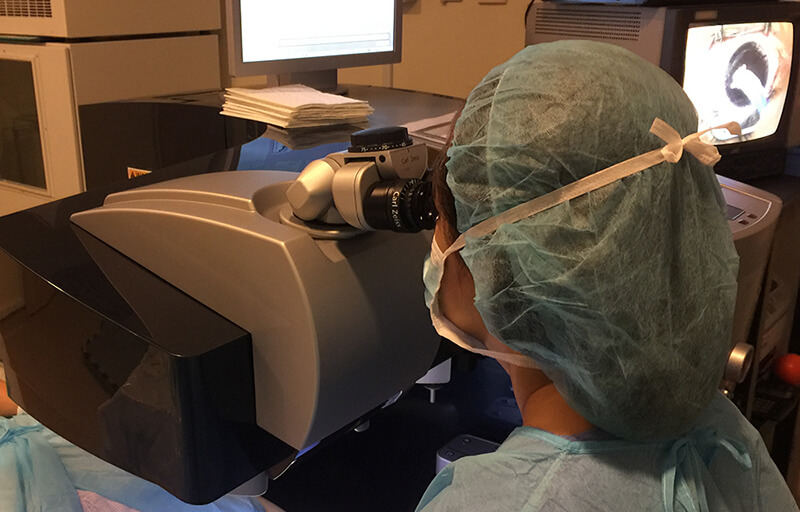LASIK Surgery in Singapore
About LASIK
What is LASIK Eye Surgery?
LASIK, or laser in situ keratomileusis, is an outpatient surgical procedure used to treat:
- Short-sightedness (myopia)
- Far-sightedness (hyperopia)
- Astigmatism
Your Singapore LASIK Surgeon will use a special laser to reshape the cornea to improve the way light rays focus on the retina (the light-sensitive “film” at the back of the eye).
LASIK is performed to decrease your reliance on glasses and contact lenses. In most cases, spectacle and contact lens independence is achieved.
Do note that if you are beyond 45 years of age and require glasses for reading (a condition called presbyopia or “lau hua”), you will probably still need your reading glasses after LASIK. There are other options for presbyopia management which your LASIK surgeon will be able to discuss with you. Some people choose a vision correction method called monovision which leaves one eye slightly short-sighted to allow for close work, while the other eye is adjusted for distance vision. Monovision works well for some patients, and your eye doctor will help you decide if you are suitable for this.
Am I a Good Candidate for LASIK Eye Surgery?
Not everyone can have LASIK or will benefit from it. Your LASIK eye surgeon will advise you accordingly.
Generally, in order to undergo LASIK surgery in Singapore, you should:
- Be at least 21 years of age
- Not be pregnant
- Be free of other eye diseases
- Have a stable refraction i.e. the prescription for your glasses shoold not have changed much in the last one year
- Fulfil certain criteria with regards to cornea thickness, cornea shape and refractive error (degree). Patients with thin or irregular corneas, severe dry eye, cataract, glaucoma, uncontrolled diabetes, rheumatoid arthritis and other collagen vascular diseases are unsuitable for LASIK.
Most importantly, you must have realistic expectations about the outcome of the procedure, and be willing to accept the potential risks associated with it. Fortunately, LASIK is very safe, and the results excellent, and most patients are extremely happy with how the procedure has changed their lives.
How is LASIK Eye Surgery performed?
LASIK is performed as an outpatient procedure. Here is what happens:
- You will be awake during the surgery and no sedation is necessary.
- The surgery is generally a comfortable experience with minimal pain.
- The eye is numbed with anaesthetic eye drops.
- A first laser called the femtosecond laser is used to create a thin piece of tissue (the flap) on the cornea.
- The flap is gently lifted.
- A second laser, the excimer laser is then used to reshape your cornea.
- The flap is replaced and smoothed out. No sutures (stitches) are necessary. The flap adheres (sticks) on its own.
- It takes generally 10-15 minutes to perform LASIK in both eyes.
In some cases, a contact lens that acts like a bandage is placed over the cornea to allow proper healing of the flap to occur. This will be removed by your LASIK surgeon, usually the next day.

What to Expect after LASIK Surgery?
- Visual recovery after LASIK is amazingly quick, but not instantaneous.
- You will find that your eye sight is still foggy immediately after LASIK. Vision usually improves gradually over the next 6 to 8 hours. By the next day, you will be able to see well enough to perform most of your daily activities.
- When the effect of the anaesthetic eyedrops wears off, some patients may experience pain, tearing, burning sensation, scratchiness and/or difficulty opening their eyes, the severity of which varies from patient to patient. These symptoms usually disappear after 6-8 hours. Most patients find the discomfort mild and bearable.
- Healing after LASIK is usually more comfortable than with other methods of surgery as the laser removes tissue from the inside of the cornea rather than from the more sensitive surface of the cornea.
- You will be prescribed antibiotic and steroid eye drops as well as artificial tears to keep the eyes moist.
Most patients are able to return to work a day or two later. Stabilization of vision takes a few weeks, and varies from patient to patient.
What Are the Risks and Side Effects of LASIK?
These include dry eye, fluctuating vision, hazy vision, haloes and glare in a dim environment and light sensitivity. Over- and under-correction may also occur, and a “top up laser” procedure called “enhancement” may be required in some cases. Serious side effects that can result in loss of vision are extremely rare, and these include severe inflammation, infection and corneal ectasia (weakening and thinning of the cornea)
What if I am Not Suitable for LASIK Surgery?
Do not despair! Alternatives to LASIK are available. Our LASIK surgery clinic provides a wide variety of refractive surgical procedures in Singapore that aim to a wide variety of refractive surgical procedures that aim to give good vision, and if you are not suitable for laser refractive surgery, there are likely to be alternatives for you. These include:
Meet Your LASIK Surgeon

